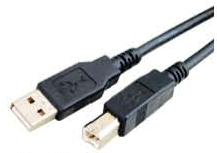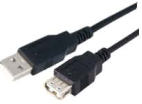
 Lan Cable
(29)
Lan Cable
(29)
 Patch Cord
(25)
Patch Cord
(25)
 Optic Fiber
(74)
Optic Fiber
(74)
 Networking Accessories
(424)
Networking Accessories
(424)
 Cable Management
(16)
Cable Management
(16)
 Networking Tools
(206)
Networking Tools
(206)
 Computer Cable
(434)
Computer Cable
(434)
 HDMI Cable
(424)
HDMI Cable
(424)
 USB Cable
(49)
USB Cable
(49)
 Computer Connector
(50)
Computer Connector
(50)
 Coaxial Cable
(1)
Coaxial Cable
(1)
 Alarm Cable
(30)
Alarm Cable
(30)
 Speaker Wire
(8)
Speaker Wire
(8)
 CCTV Accessories
(24)
CCTV Accessories
(24)
 Iphone Cable
(15)
Iphone Cable
(15)
 Computer Peripherals
(78)
Computer Peripherals
(78)
 New Products
(43)
New Products
(43)
Best USB Cables Store
USB(Universal Serial Bus) cables are required to connect most new electronic devices to computers and extending ports with USB hubs and USB switch boxes. Most electronic devices that are intended to be connected to a computer use USB 2.0 speed cables.
There are many different types of USB connections on different devices.
Physical appearance:
Pinouts of Standard, Mini, and Micro USB plugs. The white areas in these drawings represent hollow spaces. As the plugs are shown here, the USB logo (with optional letter A or B) is on the top of the overmold in all cases.
USB type A is the rectangular type found on the back of a computer.
USB A type:
USB type B is the square type found on the back of a printer. In order to connect a computer to a printer, you would need a USB type A male to USB type B male cable.
USB B type:
There are also several smaller USB connections used on portable devices. New Android cell phones and Blackberry cell phones use micro USB. Digital camera cables can be several different USB types including micro USB, mini USB 5 pin or mini USB 4 pin.
Mini B type:
We offer some USB adapters that can convert one USB type to another. In addition to the many cable options, we also carry USB boxes and products that can extend the use of USB. A USB hub can add additional USB ports to a computer that does not have enough. A USB switch box allows you to switch one USB device such as a printer between multiple computers. If you have to extend a USB cable farther than the 15ft maximum, try our CAT5 extender or USB extension repeater cable. USB over CAT5E carries USB 1.0 speeds up to 180 feet. Some older devices have serial connections, and not USB. They would require our USB to serial adapter. USB cables have become a part of our daily lives, and with USB hubs and USB switch boxes, more connections than ever are possible.

USB 1.1/2.0 A male to B male USB 1.1/2.0 A male to A male

USB 1.1/2.0 A male to B female USB 2.0 A male to mini B male

USB 2.0A male to mini 5p male USB 2.0 A male to micro A male
“A”male to “A” male/female USB cables are typically used to extend the reach of your existing USB A/B cable.or to use USB device such as memory stick on your desk instead of inserting it to the back of PC.
The Micro-USB connector is rated for 10,000 connect-disconnect cycles which is significantly more than the mini plug design,and now being widely adopted by cellphone and PDA manufactures. These include various types of battery chargers,allowing Micro-USB to be the single external cable link.
USB 2.0 cables provide transfer rates up to 480Mbps,and easily attach to any USB device A to B cables are used to connect from your USB port on Hub,PC or Mac to your USB device such as printer or scanner.
“A”male to “A” female USB cables are typically used to extend the reach of your existing USB A/B cable or to use USB device such as memory stick on your desk instead of inserting it to the back of PC.
USB 2.0 cables provide transfer rates up to 480Mbps,and easily attach to any USB device A to B cables are used to connect from your USB port on Hub,PC or Mac to your USB device such as digital camera,DVR,or PDA.
Version history
Pre releases
The USB standard evolved through several versions before its official release in 1996:
USB 1
Released in January 1996, USB 1 specified data rates of 1.5 Mbit/s (Low-Bandwidth) and 12 Mbit/s (Full-Bandwidth). It did not allow for extension cables or pass-through monitors (due to timing and power limitations). Few USB devices made it to market until USB 1.1, released in August 1998, which fixed problems identified in 1.0, mostly relating to hubs. 1.1 was the earliest revision to be widely adopted.
USB 2.0
The Hi-Speed USB Logo
USB 2.0: Released in April 2000. Added higher maximum signaling rate of 480 Mbit/s (effective throughput up to 35 MB/s or 280 MBit/s) (now called "Hi-Speed"). Further modifications to the USB specification have been done via Engineering Change Notices (ECN). The most important of these ECNs are included into the USB 2.0 specification package available from USB.org: